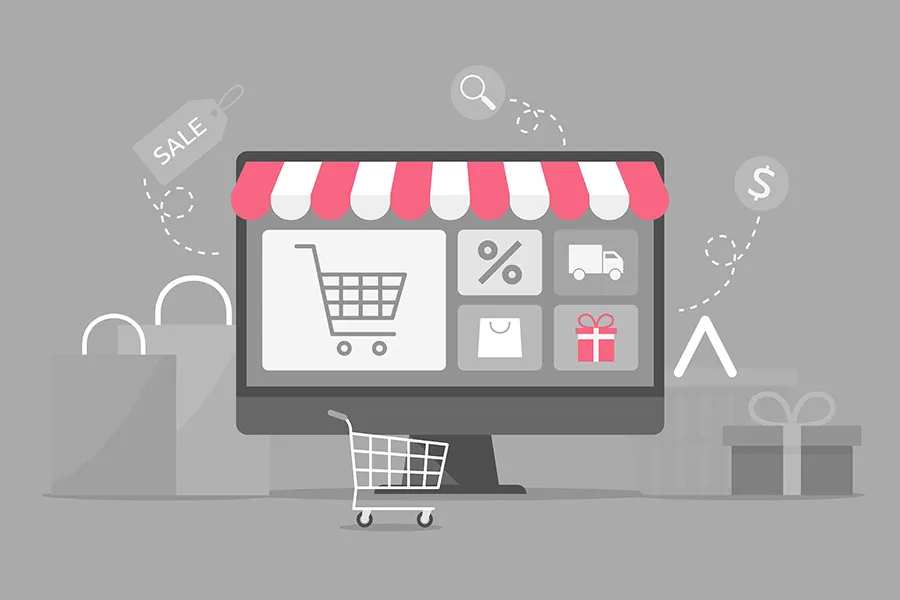How Much Does It Cost To Build An Ecommerce Website From Scratch?

It makes sense to move some of your business online, even if you have a brick-and-mortar store. Online presence creates buzz for your business while letting it grow in new and exciting ways.
If you’re thinking of moving your traditional store online, taking your first steps into the world of eCommerce, or just checking that you’re not currently overspending on your current online business ventures, examining the cost of an eCommerce website can help contextualize your most important overhead. Let’s look at just how much an eCommerce website can cost to build and run.
Things To Consider When Assessing The Cost Of An eCommerce Website
There are so many different parts to a website, and each piece will impact the overall cost. Knowing how much you want to spend ahead of time can help you decide which platform is the best choice for you and what additions you’ll be able to afford. Without a clear budget, you can easily end up overspending.
The total cost for hosting an eCommerce website in 2022 can be anywhere between $40 and $4000/month, plus $1,500 – $30,000 in website design setup fees.
Why such a big range?
Without knowing the size of your catalog, the customization you’ll require for the products you sell, your annual sales, and your overall needs, it’s impossible to create a precise estimate.
Small eCommerce stores with few fiddly products might be able to get by using free Shopify themes and minimal plugins. Larger eCommerce stores will need customization and additional hosting features like security and redundancy to help keep things running smoothly.
Below we’ll break down the options for each expense you’ll face and show you where you can save some money – and where you’ll probably want to spend more.
Remember: Time Is Money
Time is precious. Sometimes, the most significant cost of your eCommerce website can be the time spent setting it up.
Using purpose-built eCommerce software like Shopify can save some time on your end. Instead of spending time connecting different programs, designing checkout carts from scratch, and customizing every product page, you can instead just fill out a pre-designed theme, change some colors and fonts, and be done with it.
Dedicated eCommerce platforms will also include support and ongoing maintenance to keep your store up and running without having the hassle of maintaining it yourself.
A basic eCommerce website takes an estimated 100 hours to set up from scratch, and that’s assuming you have the coding experience to undertake such an endeavor. This doesn’t include adding individual product listings. An enterprise-level website can take upwards of 200 hours.
All of that time is time taken away from managing and improving your business in other ways. So when picking solutions for your eCommerce site, remember to prioritize your time as well.
Hosting Costs
You’ll need to invest in some behind-the-scenes coding architecture for your website. This includes a domain name (the web address where your store lives), web hosting (where your data is stored), and an SSL certificate (security for your website).
If you have a website already, you might have some of these checked off, or can find quicker ways to implement them. Remember to use the resources you already have; just because you want an eCommerce platform, doesn’t mean you have to start from scratch!
Depending on which eCommerce platform you decide to use, some of this architecture may be included in your cost. For example, SaaS (Software As A Service) solutions (like Shopify or BigCommerce) often include hosting in their pricing hierarchies, and you can purchase your domain name directly from them.
Self-hosted solutions (like WooCommerce) will require investing in a separate hosting solution, which will take time to research. Self-hosted solutions will also require more technical expertise to deploy as you’ll need to install the eCommerce software on your server.
The average costs for each aspect of hosting can be found below for a small to medium-sized business:
- Domain name: $10 – $20 per year
- Web hosting (SaaS solution): $29 – $250/month
- Web hosting (Self-hosted): $2.99 – $200/month
For a large-scale company with a busy site that might see thousands of daily visitors, your system requirements will increase. You’ll need increased redundancy, the ability to host a lot of traffic without decreasing your page load time, and tighter security.
Hosting costs can vary but expect to pay upwards of $1000/month for larger sites.
Software Costs
Every eCommerce website has similar components: product pages, inventory management, carts, and checkout pages. Building the functionality for each component takes time, skill, and effort, so most eCommerce businesses rely on a SaaS solution that’s purpose-built for eCommerce.
As with most software solutions, there are different costs associated with smaller and larger businesses.
Small to medium-sized businesses
At the low end, some eCommerce SaaS offerings start at about $20-$30/month and offer different plans based on your volume of sales and the functionality you need. On the upper end, you can expect to see prices of $90/month, usually including more analysis tools and programs to help organize how your eCommerce site is performing.
Larger Businesses
The more customizable your eCommerce site, the pricier the set-up cost. However, big businesses with a big, diverse product catalog or unique shopping journeys such as wholesale orders will need to invest in a more configurable platform. It won’t just come down to a few extra odd product types; you’ll be managing a whole range of diverse inventory and products, and most of the time they won’t fit nicely into the same categories.
There are platforms dedicated to providing larger businesses with a whole suite of options, but it’s not quick and easy to get up and running.
These platforms (such as Magento) aren’t designed to be set up by any average business owner. They typically require some more coding and development skills. There will be an additional setup cost associated with the development of your eCommerce site, as well as an ongoing cost for maintaining and updating the site. The average setup cost for a larger business is about $5000, with a monthly cost averaging around $1800 a month.
Website Design
Now that you have an eCommerce site hosted on a domain, you’ll need to make it look good. That includes creating a sleek layout, updating the branding, uploading glamor shots of your products, and designing the overall flow of your website.
You can either choose to work from an existing template or theme or custom design a website that is unique to your shop. Each option comes with its benefits and setbacks.
Lower Cost Designs: Existing Template And Free/Premium Themes
Most SaaS platforms have theme and template stores that you can easily apply to your site yourself. They offer pre-designed product pages and easy-to-update page layouts. While some might not be free, they’ll be much cheaper than designing a custom design through a graphic designer.
You might even be able to find a few free themes for more popular software like Shopify and BigCommerce. However, these templates may not be a perfect fit for your business, and using one of the popular templates may not be enough to make your shop stand out. Consider investing in additional customization to ensure you get exactly what you (and your customers) need.
The cost range for premium themes can run from $100 to almost $2500 for more intricate designs.
Higher Cost Designs: A Graphic Designer
To give your site a competitive edge, you may opt for a custom design, complete with custom functionality. A custom design can be a game-changer for bigger businesses that have additional requirements and a large enough audience to support them. Hiring a graphic designer to create the design for you can save you some time, but will cost you much more money. The range for even simple graphic design work on a smaller site could cost around $4000, with the price varying according to the project.
You can find a sweet spot by using a free theme and then implementing some small design edits created by a graphic designer. This can still be somewhat costly but can give your eCommerce site a fresh look without costing you thousands of extra dollars.

Payment Processing Software
While there’s no initial startup cost with most payment processing software, it’s an expense that you should include in your eCommerce financial planning, since it will end up eating up a small percent of just about every sale you complete. Different platforms offer different processing options, each with its own cost.
Here are a few of the most popular eCommerce sites’ payment processing options:
- PayPal or Stripe for WooCommerce: 2.9% + $0.30 for transaction
- Shopify Payments for Shopify: – between 2.4% – 2.9% + $0.30, for Basic Shopify and 2.4 +$0.30 for Advanced Shopify, plus an additional 2% per transaction for third-party payment gateways.
- PayPal or Stripe for BigCommerce:– between 2.4% – 2.9%, depending on your BigCommerce plan + $0.30 per transaction
Search Engine Optimization (SEO)
The most well-designed, gorgeous website won’t make any money if no one can find it. Once you make your eCommerce store live, anyone can find it. However, if it’s not optimized properly, search engines won’t recommend your website to others on their Search Engine Results Pages (SERPs).
That’s why it’s important to build your eCommerce website with SEO in mind.
It’s much easier to start with a site that’s optimized and built ready to be seen rather than trying to organize your content and improve it after it’s already been built. Having SEO features built right into your design can save you money down the road. Things such as load time, keyword density, and authority of a given topic can help improve your site’s visibility.
Most SEO agencies will charge a monthly retainer fee, with basic packages running around $1000 a month for bare minimum optimization and monthly maintenance.
Additional Software And Plugins
There are many other tools and services you can take advantage of to make your eCommerce site stand out. Here are just a few ideas of additional tools you may want to include in your budget:
- CRM (Customer Relationship Management software) is a database that organizes and stores all of your customer information. It can help personalize your marketing efforts through segmentation.
- Search functionality: adding additional search functionality to your store may require a plug-in, but your customers will be able to find products more easily.
- Abandoned Cart Saver: other extensions, like an abandoned cart saver, can add to your total monthly cost, but they also can increase your conversion rate by pulling potential customers back to complete their orders.
Content And Copy
You could write the copy and make images for your website yourself. But as we mentioned at the beginning of the article, time is money. Whether you spend time on it or decide to outsource, your content comes at a cost.
If you’re outsourcing content creation, your costs will include:
- A copywriter for website text including product descriptions and blog posts
- Professionally taken product images
- Creation of videos and other multimedia
The cost of hiring a creative varies hugely, but you should expect to pay a couple of hundred dollars per day, at least. On the one hand, outsourcing might be more expensive, but it also frees up time for you to maintain other aspects of your eCommerce presence. Make sure your briefs are extensive and detailed to ensure a positive and timely outcome.
If you already have content writers and copy editors, you might not need to outsource this. But this will create more responsibilities and tasks for your current team, so that might come with increased hours, stress, and even pay bumps.
So, How Much Does An eCommerce Site Cost?
This will vary heavily depending on your business, what kind of digital presence you currently have, and a whole myriad of other factors. Of course, you could always go with a SaaS company that packages all of this into one easy price.
But this checklist of different aspects of an eCommerce business is a great starting point to plan out what your eCommerce business might cost to build. It can contextualize whether it’s feasible for you to start up, and from there, you can decide on how to build your own digital storefront.

